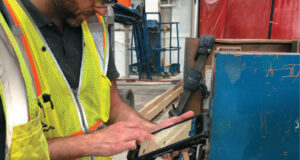Consistency and conformity.
Not two of the most exciting words in the English language, but certainly some of the more important when it comes safety. Why? Because when employee workforces conform to safety requirements and regulations, and consistently perform according to their provisions, the rate of recorded incidents (near-misses or accidents) almost always drops.
One of the biggest factors in bringing consistency to safety in the pulp, paper, and packaging industries has been the application of advanced technologies. From recordkeeping to online training to the more recent use of inspection and demolition drones, technology is helping to revolutionize safety adherence. It can be as simple as using a shared drive or as advanced as wearable technology, but nowhere has it been more profoundly useful than in the realm of recordkeeping.
“If you want a true determination of how compliant you really are, it’s all in the records,” says Employee Health and Safety Manager Trent Livingston at Rimcor, Inc., a specialty contractor focused on combatting heat and corrosion problems in mills, plants, and other industrial settings. “By applying technology to recordkeeping, employee health and safety has gone from the primitive days of filing cabinets to a world of immediate access, integrated information, and instant reporting.”
It isn’t just about ease of integration. Livingston notes that the ability to instantly access individual employee safety training records has been a key compliance factor, as well as an added customer benefit. With the advent of industry-specific online training, connecting the two has never been better. “There are many times when we don’t get advance notice that we are needed ASAP at a client location,” said Livingston. “We need a fast, efficient, and accurate way to provide proof that our employees have received all the necessary safety coursework.” Now, all that information is instantly available at the click of a mouse, connecting each employee with his or her specific safety course record, to the client’s needs, and to regulatory requirements.
Livingston notes one of the many benefits of partnering with an industry-developed safety orientation and verification program is being able to take site-specific orientations. “In this industry, it’s not unusual for a large parent company to have 25 different mills with 25 different site orientations,” Livingston said. “It’s incredibly time-intensive to make every employee take individual trainings that may be redundant.” Instead, when a major producer participates in the program, a universal site orientation is created that can be applied across the board, saving both entities much time and effort. “They don’t need to provide the training, and we are able to prep our workforce on the specific needs of that company and that location in advance. It’s totally a win-win,” Livingston said.
The biggest attribute, he believes, is one Rimcor is currently test-running at one of its participating clients’ sites. “Our employees have been issued badges that are electronically encoded with their respective safety coursework,” Livingston said. “When they get to the facility gate, the badge is scanned for instant verification of required coursework. That includes any courses that may have been taken just prior to arriving at the mill.”
The program’s ability to quickly run reports and generate instant access is the factor that Livingston feels is so important to his company’s recordkeeping compliance. “Any mill or plant participating in the program can do the same thing. It’s amazing how much more efficient and effective you can be using a program that integrates this well.”
Reflecting on how far the industry has advanced from retrieving records out of filing cabinets, Livingston uses a Rimcor-related analogy: Years ago, performing a safety inspection on a mill tower meant investigating every possible avenue to ensure a safe and compliant approach. This may have meant hiring a licensed climber who would rappel the tower’s edifice inside and out or employing an inspection chair that would ride the tower walls up and down, or possibly erecting intricate and detailed scaffolding. All took incredible lead-up time and held inherent safety risks. Today, Livingston says, thanks to the introduction of drone technology, similar inspections require only a licensed and competent drone pilot.
“Data is power,” Livingston concludes. “If you have data readily available it makes you more efficient and immensely more effective at what you do—especially when it comes to recordkeeping.”
TAPPISAFE is a web-based orientation program that allows the workforce to take training online so they arrive at the mill ready for gate entry; learn more at tappisafe.org. Learn more about Rimcor, Inc. at rimcor.com.
 Paper 360
Paper 360

